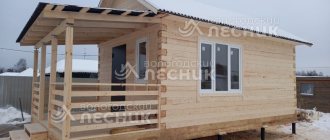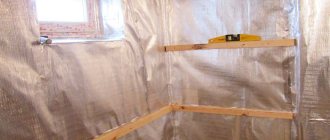Many people face the problem of water supply in winter baths without constant heating. And everyone is looking for a solution that would be optimal specifically for their case. We think this is right. However, in order to choose the best option, you need to have an idea of all available at your disposal. This article will be an overview of all effective options.
The water in the bath freezes, why?
The question of why water in a bathhouse freezes in winter is inappropriate - because zero temperature is enough for water to pass from a liquid to a solid state of aggregation. This is understandable. But in the conditions of early cold weather and severe winter in most of our country, a practical question immediately arises: how to properly install water in a bathhouse so that it does not freeze in winter?
What is the risk of water freezing in winter in a bathhouse without heating? Firstly, water will not be able to pass through the ice plug , and secondly, frozen pipes will be broken by the ice . This is due to the fact that the volume of liquid water and ice is different for the same mass. That is, water (stationary, mind you!) fits freely inside the pipe, but ice is already cramped. And the force of his pressure on the walls is such that they cannot stand it.
Since rupture of pipes will require replacement of communications , it is better to immediately install the water supply in the bathhouse so that it does not freeze in winter.
What options do we have? For the winter, the water supply in a bathhouse without heating can be insulated with fur coats and shells , or you can use heating devices to keep the pipes warm. You can use the properties of the soil and run water supply to the bathhouse below the soil freezing level. There are other options, but first things first.
The most common diagrams for connecting pipes in a bathhouse
In addition to the material and climatic conditions, when laying a winter water supply system, you will need to take into account the method of supplying water to the bathhouse. As a rule, water for the steam room and washing department at the dacha can be supplied in three ways:
- From a centralized water supply system;
- From a well drilled at a distance of 15-20 m from the bathhouse;
- Collect water from a well located a short distance from the bathhouse building.
Connecting a winter water supply for a bathhouse in all cases is somewhat different from the water supply system for a summer house or residential building due to the lack of constant heating of the room. The most difficult connection is considered to be the connection of the winter water supply to the centralized water supply line of the holiday village.
Water in the bathhouse in winter without heating
Let's start with how you can get water into the bathhouse so that it doesn't freeze in winter. More precisely, we will list all the methods, and separately mark those that are suitable for supplying water to the bathhouse in winter.
From the water supply
If in the area where your bathhouse is located there is a well-functioning main line with good pressure, then why not use it to supply water to the bathhouse?
Basically they do this: they bring water into the house, and from the house they pull a pipe to the bathhouse. There are no fundamental differences between connecting directly to the main line or to house communications, so let’s move on to a description of how exactly you can run water from the water supply (of course, you can run it at any time).
Plumbing on top (by air)
ATTENTION! This method is least suitable for supplying water to a bathhouse for the winter, unless you take care of very significant insulation, for example, with heating wires.
The essence of the wiring is that the pipe extends above the surface of the earth . Moreover, the method itself can be called “over the top” or “over the air”.
In order to ensure the reliability of the structure over long spans, it is recommended to use a cable to which your pipe will be attached - similar to how a wire is suspended to transmit electricity through the air.
To prevent the cold water in the bathhouse from freezing in winter, the pipes must be laid at a large or slight slope. In this case, it is enough to turn off the water from the house or on the main line, and open the tap in the bathhouse and let all the water in the pipes drain. If there is no water, there will be nothing to freeze , so even polypropylene pipes will not burst.
IMPORTANT! Thus, the first rule on how to prevent the water in the bathhouse from freezing in winter is to drain it immediately after using the water supply.
However, there is one trick, which you will learn about in the video below. If you use it, there will be no water left in the pipes at all:
But this is not the only way to run water supply to a bathhouse in winter from above. You can do the same thing, but use, firstly, polyethylene pipes (LDPE), because they are more elastic, and under the influence of expanding ice they are more likely to swell than break, and secondly, to ensure the protection of the pipes from the environment and heat.
IMPORTANT! Polyethylene pipes are only suitable for cold water, because hot water causes them to stretch. But their advantage is that you can use detachable fittings on them, that is, you can do without welding during installation. It's good to have all connections visible, because detachable fittings will leak sooner or later.
Watch the following video to get an idea of exactly how protection and insulation is provided:
If you understand that the only reason why pipes can be torn by ice is the water remaining in the pipe, then you can make your life extremely simple by carrying water into the bathhouse by air in winter and never having to deal with the fact that it has frozen. In this case, neither heating nor insulation is required - it’s enough just not to place a tap at the end of the pipe:
From the well
We will assume that you already have a well. In order to power a bathhouse from it, you will need the following:
- Lay a trench from the bathhouse to the well, and the desired depth of depth is one that exceeds the depth of soil freezing in your area.
- Place the pipe in the trench. And for insulation, “fur coats” made of foamed polymers are put on.
- Make a hole in the wall of the well and insert a pipe into it, connecting it to the pump that you intend to use. You can use a flexible hose to make the connection, and also install a check valve so that water from the system does not return to the well.
- Insulate the walls of the well. But this is done at the stage of its construction, so let’s just say that the protective house must also be insulated - this is necessary so that the water surface does not freeze in winter.
- Since part of the pipe is inevitably brought to the surface for installation in the bathhouse, you need to take care of insulating this area, in particular, it can be equipped with a heating cable, because the polymer “coat” may not save this area from freezing.
Heating cable. Photo by Petrovich.
By the way! The heating cable can be laid all the way to the pump, but underground temperatures are above zero, if this is not a permafrost zone.
From the well
If a well is drilled on the site, then you can supply water to and from the bathhouse for the winter.
There are many different options for schemes for carrying water into a bathhouse from a well, which is due to different specifics, but there are elements that will remain unchanged in any case.
The minimum set required for supplying water from a well is the well itself, a pump and a hydraulic accumulator.
There are three types of wells - surface (upper water), up to the sandy horizon and up to the limestone horizon.
Surface ones are most often not suitable for hygienic procedures, because they contain wastewater from the sewerage system.
Up to a sandy horizon can only be good if there is a layer of clay or loam separating the sands from surface waters.
The best quality water is from artesian wells, but there it can be hard (contain carbonates). However, for a bath it is better than E. coli in the washing water.
Pumps are also different, the main division in our case is into deep and surface. The first ones dive into the well itself, the second ones work in the bathhouse.
Deep well pump. Photo by Leroy Merlin.
ADVICE! Pumps and pumping stations vary in power. You need to take the one that is a little more powerful than what is needed in your case. At least one meter more water column.
When calculating the power, it is also necessary to add to the height of the water column the distance from the well to the pump at the rate of: 10 m of distance is equal to 1 meter of water column.
The third necessary element is a hydraulic accumulator. This is a container with a rubber ball filled with air inside. Water compresses it when the tank is filled, air contracts in volume and resists the water. The pressure switch ensures that it remains within an acceptable range.
Hydraulic accumulator for cold water. Photo by Maxidom.
Usually a cleaning filter is installed after it. Which one depends on how polluted the water is. There may be several filters of varying degrees of purification.
Next, you decide for yourself whether you will have a storage tank or not, and if so, where it will be located. The same applies to the heating column or boiler. The main thing is that filling water from a well requires only the elements listed above, the rest is optional.
Water supply to the bathhouse from a well
Very often, the main source of water for a bathhouse at a dacha or in a suburban area remains an ordinary well, dug quite far from the steam room. You have to take water from the well using a submersible pump. The water supply pipe is laid in the ground to a depth of at least 2 m and led into the well shaft through a hole in the side wall. A rubber corrugation or hose for the electrical wiring supplying the pump is laid along the same line.
To avoid defrosting of the winter water supply, a check valve is not installed on the pump, and a drain air valve is installed on the inlet line in the bathhouse. After completing the bath procedures, it is enough to open it for 10-15 minutes so that the water runs back into the well. The liquid can drain without an air throttle, but the process will be quite long, and in severe frost the water at the drain in the well shaft may be covered with ice.
How to run hot water
If you have a hot water supply line, then there should be no problems with hot water in the bathhouse in winter. Of course, if the highway is functioning normally.
Everyone else will have to fend for themselves. At worst, there is a stove in the bathhouse, the heat of which in large quantities simply “flies down the chimney” in the literal sense - the gases in the chimney do not have time to give off heat and escape too hot.
But you can also install a boiler so as not to wait for the stove to heat the water in the tank. However, first things first.
How to install plumbing in a bathhouse so it doesn't freeze
Well, the method itself and the necessary set of elements for wiring hot water supply do not differ from those for cold water.
The only difference will be in the pipes - after all, pipes for hot water should not be deformed from high temperatures, so polyethylene ones are not suitable. Take those marked for DHW .
Polypropylene pipe for hot water supply. Photo by Petrovich.
But since we are talking about a bathhouse, that is, about a building with periodic use, then with the taps closed, of course, the water in the system will cool down, and in cold weather it will turn into ice and burst the pipes.
Therefore, the owner must decide exactly how he is going to supply water to the bathhouse and ensure complete drainage of water from the bathhouse in winter.
There are two options: on top and underground . In both cases, the water is shut off in the house or at the point of connection with the main line, and what remains in the system must be drained.
IMPORTANT! The slope of the pipeline towards the drain should be 0.02-0.05 degrees.
In order not to repeat ourselves, we will not describe the drainage device in detail here (it is common to all water supply systems); instead, we suggest going down to the corresponding heading in this article.
Boiler or water heater in a bath without heating
We have already said that an alternative to the main hot water supply can be an autonomous boiler or water heater. Moreover, in this case, you don’t even have to wait for the stove to heat the water, because gas or electricity does it for it in a separate installation.
any are now called boilers . In fact, the choice is made between three options:
- wood-burning water heater of instantaneous or storage type;
- gas water heater of instantaneous or storage type;
- electric water heater of instantaneous or storage type.
As you can see, the difference lies in what kind of fuel will be used, and whether it will be a storage tank, or water will only flow through it.
In a large bathhouse, a boiler is a necessary thing in winter. However, we can immediately say that at this time of year, instantaneous boilers may simply not cope with the task. Therefore, in a bathhouse without heating in winter, it is better to use a storage type water heater.
ADVICE! Pay attention to the instructions for the water heater - there is often a warning there that the unit is not intended for operation at temperatures below 5 degrees Celsius. Consequently, it can be started in cold weather only by warming up the bathhouse with a stove.
Since we are talking about rooms with periodic use, it is important to know how to protect equipment from low temperatures during the cold season.
So, you can purchase a water heater with the function of constantly heating water, but this is convenient for those who use the bathhouse quite often in the winter. Because if during the period of absence the air temperature in the bathhouse drops below plus 5 degrees, then heating will occur under conditions for which the manufacturer is not responsible.
Draining water before leaving the site is the rule for all elements of the water supply system in unheated rooms in winter. It also applies to the boiler. For greater convenience, you can drain it directly into the sewer.
A dry heating element in a boiler is better than a wet one - the dry one is not affected by the fact that you periodically drain the liquid from the tank, and this causes the wet one to deteriorate; its corrosion protection only works if the anode is in water.
Sunsystem indirect heating boiler. Photo by Leroy Merlin
Here is such a set of facts, but, as usual, what is better turns out to be more expensive.
Tips for installing water supply for baths
In order for the system to serve for a long time and be reliable, you need to plan the construction of the bathhouse and water supply carefully, taking into account all the nuances.
Selection of materials
It is very important to choose the right pipes for supplying and distributing water. They must be durable, easy to install and withstand significant temperature changes.
- Steel pipes, for which there were practically no alternatives in earlier times, are practically not used today due to their instability to corrosion. They wear out quickly, and their replacement is associated with large expenses and a large amount of work.
Steel pipe after several years of use
- Polyethylene pipes are resistant to low temperatures. They are flexible and durable, easily connected using special fittings. They are convenient to use for laying summer water supply. PE and HDPE pipes do not require preservation; it is enough to simply drain the water from them for the winter.
Polyethylene pipes and fittings
- Polypropylene pipes are indispensable for the installation of external underground water supply and internal wiring. They are securely connected by soldering.
Glass fiber reinforced polypropylene hot water pipes
- Copper pipes are the most expensive. They have excellent performance characteristics. Their main area of application is a hot water supply system in a bathhouse with a remote hot water tank.
Copper pipes in the bath
Installation features
The pipeline must be protected from external influences and soil pressure. To prevent pipes underground from receiving mechanical damage, the instructions recommend laying them on a sand bed or placing them in a corrugated hose of a suitable cross-section.
This will prevent them from being deformed and compressed by the layer of soil located above, and will protect against its seasonal movements.
In order to have access to a sauna throughout the year, the water supply in winter needs to be protected from freezing. And first of all, this applies to complex pumping equipment.
- If the pump is submersible, it is in the water. It can freeze only in severe frosts if it is standing close to ground level. In this case, it is necessary to insulate the outer walls of the well and equip it with a lid.
Warm cover for the well
- The presence of a pumping station will require the installation of a caisson or an insulated pit in the bathhouse.
Insulated caisson
- Any system must have drain valves to be able to completely drain water from equipment and pipes during extreme cold weather.
Faucet for draining water to the street
Plumbing diagrams
Despite all the variability of the task facing you, it can be typified. This will reduce many details, but, on the other hand, it’s hardly worth taking on the task of installing a water supply system in a bathhouse in the winter without heating without experience. Schemes will not replace it.
We will give one scheme for each case described above. By the way, the decision about the need for a heating cable in each specific case is up to you. It may not be labeled, but remember that such a solution exists.
Winter water supply from a well (with temporary accommodation in winter)
Winter water supply from the well of a bathhouse with temporary residence.
Regarding this scheme, it is worth adding that the pumping station can also be located in a bathhouse, and a caisson in a well is not at all necessary.
From home to cold bath
Conducting the main water supply to the bathhouse through a trench.
You can bring main water into the bathhouse either from the main itself or from home. In the latter case, it can also be carried out by air.
ADVICE! Pay attention to the drain pipe in the well and the tap on it, as well as the indication of the slope, which will ensure the drainage of water from the underground part of the pipes.
Well water
Water supply diagram for a bathhouse from a well with a pump. Photo from the site sib-bur.ru
Despite the fact that the pipe and cable are shown here separately, running even at some distance from each other, in fact they go together, inside one protective pipe, while the cable is wound to the water pipe.
Piping inside the bathhouse
One of the typical options for laying pipes indoors is shown in the diagram below.
Water enters the building through the floor or wall of the dressing room. A mud filter and a tap for draining water from a storage tank, usually raised into the attic of the building, are also located here. The design of the water supply system provides three independent drainage systems:
- From a storage tank;
- From the cold circuit of the boiler;
- Drain from the hot circuit connected to the furnace heat exchanger.
Despite the apparent complexity, the scheme is quite simple and effective in operation. After shutting down the furnace firebox, excess steam pressure will squeeze water out of both the boiler and the water storage tank. The drain taps located under the subfloor in the bathhouse are left open, which ensures a relatively complete release of liquid from the water supply in a short time.
Water supply for a bathhouse in winter without constant heating
Above we showed only diagrams for adding water to the bathhouse. But we should also talk about how to take care of the main water supply points: the shower and toilet.
How to turn on the water so it doesn’t freeze: shower in the bathhouse
Since the bathhouse is an unheated room, in the absence of the owners and the heating of the stove, the temperature in it becomes the same as outside. And water freezes at zero. Internal communications are bursting with ice just as much as external ones .
The basic rule for showering in a bathhouse in winter is that if the hose is flexible with a watering can, then it must be placed on the floor or at the bottom of the shower stall before leaving. This will ensure that the water that is inside the hose drains out.
taps must be left open , because when draining, air enters through them instead of draining water.
Everything else concerns the general drain, which will be discussed further.
How to run cold water into a bath toilet
Frost breaks toilet bowls with remaining water in the same way as pipes. Therefore, you can’t just leave the toilet in the bathhouse in winter. Care must be taken to ensure that ice does not form in the toilet.
This can be achieved by various means. You can fill the toilet seat with antifreeze or other liquid that changes the freezing point.
IMPORTANT! Keep in mind that you need to choose a liquid according to the climatic conditions in which you live - if the temperature drops below the freezing point of the selected liquid, ice will certainly form.
Alternatively, you can use a solution of table salt made at the limit of dissolution, that is, when more salt simply does not dissolve. Its freezing point is minus 21.2 degrees.
If frosts below this mark are expected, use another liquid - based antifreeze , for example. But keep in mind that this is poison for humans! Alternatively, it would be possible to prevent it from evaporating by using an oil film on the surface, but we do not know how oil will behave with ethylene glycol.
However, let’s remember why we need liquid in the toilet siphon - to prevent odors from the sewer from entering the toilet. There is another option - without poisons. You need to completely dry the toilet seat (using a rag, for example, or using the clever device described in the video below:
After draining, you can place an inflated balloon or even just stuff a rag - this is done to prevent the flow of air from the sewer. We think this is better and easier than leaving the liquid.
Well, don’t forget to first drain the water from the tank completely.
To conclude the topic, there is a video that says, in principle, the same thing as we said above, but you can check











